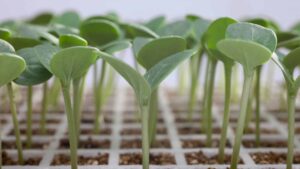ISF lays the ground work for national seed associations to engage with their governments and other organizations to help facilitate discussions around plant breeding innovation, the implementation of ISPM 38 and seed choice.
Setting strategic directives for policies and positions on issues is really just the tip of the iceberg for what the International Seed Federation (ISF) does. After that, the real work of coordinating with national seed associations, governments, and other non-government organizations (NGOs) begins.
It’s in these conversations that trust must be built, and points of commonality identified. Three areas where these actions are of utmost importance are the:
- Pursuit of consistent regulatory frameworks on plant breeding innovation across countries.
- Implementation of the International Standard for Phytosanitary Measures on the International Movement of Seed (ISPM 38).
- Quest to provide more and better seed choice for farmers.
Achieving consistent policies for products developed by plant breeding innovations to enable their use and to ensure uninterrupted trade is a top ISF strategic objective.
Prior to the 2017 World Seed Congress, ISF developed a concept paper on the consistent criteria for the scope of regulatory oversight, with the aim of providing guidance to national seed associations for their discussions with governments and stakeholders.
“An underlining principle for determining these consistent criteria is that ‘plant varieties developed through the latest breeding methods shouldn’t be differentially regulated if they are similar or indistinguishable from varieties that could have been produced through earlier breeding methods,’” explains Szabolcs Ruthner, ISF regulatory affairs manager.
This paper served as the basis to engage with key governments with the help of the respective national seed associations to ensure alignment.
Ruthner says the first step toward developing consistent policies is to have an agreement among governments on the criteria that will be used to determine the regulatory oversight in their countries. The second step, he says, is to agree on the process used to determine whether a product falls within or outside the scope of the existing GMO regulation.
“We’ve translated the concept paper into many languages, and it’s been used in several international meetings with governments and just recently at an international workshop in China,” Ruthner says. “Because of the demand for more written information from the concept paper, we have converted its main message into a position paper that will only help to increase our capacity for outreach.”
At the same time, he says, ISF is working on a set of guiding principles for information and communication that will be used for further engagement with the value chain.
On the ground, there are only a few countries that have actually established policies for how they will handle products derived from plant breeding innovations. Among them, Ruthner explains, he sees more commonality than divergence.
“One of the best examples can be found in South America where countries see the value of aligning policies,” he says. “Argentina was the first country with a regulatory framework for products derived from plant breeding innovations.
“The resolution establishes the procedure to determine in which cases a crop developed by the latest breeding methods doesn’t fall under the current biosafety regulation. Based on the example of Argentina, Chile, and to some extent Brazil, developed their evaluation system following the same criteria.”
To date, Australia, South Africa and Japan have not decided if or how their GMO regulation will apply to plant breeding innovations. Ruthner says from the ongoing discussions, it seems these countries are aware of the importance of consistent regulations.
In the European Union (EU), plant breeding innovation continues to be a sensitive topic from a political perspective. At the request of nine French NGOs, the European Court of Justice was asked to clarify if the varieties obtained by mutagenesis are exempt from the scope of the EU directives regulating GMOs. The EU Commission has decided to wait for the outcome of this case before acting on this topic.
“The opinion of the advocate general revealed in January was rather positive,” Ruthner says. “He stated that organisms obtained by mutagenesis are in principle exempt from the obligation of the GMO directives provided that they don’t involve the use of recombinant DNA.”
Ruthner notes that this opinion is only advisory and doesn’t bind the court in its final ruling.
Because most countries haven’t decided if, or how, they will regulate plant varieties developed using plant breeding innovations, ISF’s Plant Breeding Innovation Working Group has a great deal of work on its plate.

Michael Keller, ISF Secretary General

Szabolcs Ruthner, ISF Regulatory Affairs Manager
Coalitions for a Unified Voice
“In many countries, the possible regulation of plant breeding innovations is under public consultation,” Ruthner says. “It’s crucial to submit a joint opinion from the seed industry and to avoid sending mixed messages from players within the same circle.
“This requires a tremendous effort and coordination among different stakeholders where ISF has a leading role.”
Ruthner says the conversations along the value chain need to be strengthened.
“We need a unified voice going out to decision-makers, clearly articulating the benefits that these new innovations can bring to society and the need for having a regulatory framework that enables their use based on consistent criteria,” he says.
Within some countries, plant breeding innovation coalitions are being formed, bringing together private and public researchers, farmers, grain traders, retailers and players in the food industry — working together to achieve greater alignment.
An area where communications is absolutely critical, Ruthner says, is the grain trade.
“Although grain traders recognize the benefits of these innovations, they are concerned about potential trade disruptions if new plant varieties derived from one technique are exempt from regulation in one country but not another,” he says. “ISF has been in constant dialogue with the International Grain Traders Coalition and is working on a science-based approach to the regulation of the latest breeding innovations with the goal of causing the least amount of disruption to the grain trade.”
Additionally, Ruthner says ISF needs to strengthen its presence in international platforms, such as the Organisation for Economic Co-operation and Development, G20 and Inter-American Institute for Cooperation on Agriculture, where discussions are already underway.
“These platforms are capable of influencing the national regulatory policies, so it’s crucial that we make our voice heard in these debates,” Ruthner says.
Furthermore, just prior to the kickoff of this year’s World Seed Congress, the Plant Breeding Innovation Working Group, which brings together 30 representatives of companies and seed associations from around the world, will meet to agree on the next steps of the strategy and its implementation.
“I’m really excited about the continued and increased participation and contributions in these discussions and the work to help drive this issue forward,” says Michael Keller, ISF secretary general. “Overall, we’ve been very strategic in our approach, and we are making great strides.”
If consistent regulatory frameworks for plant breeding innovation are deployed across countries, it’s these same plant breeding innovations that can help to facilitate more and better seed choice for farmers around the world.

Hélène Guillot, ISF International Agricultural Manager
Providing More and Better Seed Choice for Farmers
ISF strongly believes that all efforts should be made to allow family and subsistence farmers from developing countries access to progress — that being better seed choice, says Hélène Guillot, ISF international agricultural manager.
“There is no space for sterile opposition when it comes to the vision for what a seed system should do,” Guillot adds.
Having witnessed a number of seed systems, ISF’s leaders are convinced that it should be up to farmers to choose what they plant, and nobody should be permitted to limit access to scientific advances.
“A farmer in Namibia should not have to wait decades to get access to what other farmers already have or will soon get benefit from: modern varieties developed with plant breeding innovations, such as cellular biology, molecular biology, double haploids, and tomorrow Talen and CRISPR CAS9,” Guillot says. “These technologies help breeders and farmers together achieve better yields, face climate change, and are even more critical to bring to developing countries.”
Joseph Gafaranga, secretary general of the Rwandan farmers organization (IMBRAPA), which represents more than 27,000 farmers, spoke at a roundtable organized by the World Seed Partnership that was part of the International Treaty on Plant Genetic Resources for Food and Agriculture Governing Body’s Seventh Session.
He said that in Rwanda, only 10 percent of the seed is certified, and that farmers cannot grow their business with such inputs.
“Hearing Joseph’s story and many others like it in geographies around the world, ISF is committed, more than ever, to its vision: a world where the best quality seed is accessible to all,” Guillot says. “Farmers all around the world should be considered as entrepreneurs, who are not only feeding their families but who are also making a living from this endeavor in order to send children to school and to access medical treatments, electricity, clean water and the list goes on.
“Running a business implies being able to make a choice in terms of what crops a farmer wishes to produce.”
To help, some NGOs are working on the ground with farmers from developing countries. An interesting example, Guillot says, is Fair Planet’s use of trial fields in Ethiopia. In these trial fields, local farmers can see and choose varieties that best suit their needs. Proposed varieties transition from local landraces to improved varieties from global seed companies that are partnering with Fair Planet.
Farmers also participate in trainings to make the best use of the varieties they choose to grow.
On this front, ISF has developed a position paper that is up for adoption during the World Seed Congress. The paper, Guillot says, calls for the recognition of the work done by breeders — helping to shape the availability and access to crop genetic resources.
“Access to high quality seed is the way forward for farmers to make a living from their activity and for countries to ensure food security for their people,” she says.
To ensure farmers have access to high quality seed and seed choice, it must be able to move more freely from nation to nation. Thanks to the adoption of the International Standard for Phytosanitary Measures on the International Movement of Seed (ISPM 38) in April of last year, this is on the horizon.
ISF has prioritized its efforts to bring awareness to members and to promote the implementation of the new standard.

Dennis Johnson, ISF Seed Health Manager
Facilitating the Safe, International Movement of Seed
Dennis Johnson, ISF seed health manager, explains that the International Plant Protection Convention (IPPC) develops ISPMs to provide guidance to countries on the establishment of a phytosanitary framework to manage the pest risk associated with the international movement of plants and plant products.
“ISPM 38 is important as the guidance in this standard is specific to the management of pest risk associated with the international movement of seed,” Johnson says. “While adoption of the standard by the IPPC was important, without implementation at the national level, ISPM 38 will have little impact.
“Countries must now align their existing phytosanitary regulations and processes for establishing those regulations for seeds with the guidelines provided in ISPM 38.”
To help, ISF held a thematic day last year to launch its efforts related to ISPM 38, “The International Movement of Seed – You Can Make a Difference.” Nico Horn, member of the IPPC Standards Committee and senior policy advisor of plant health at the National Plant Protection Organization (NPPO) of the Netherlands, provided an introduction to the IPPC, the IPSM creation process, and IPPC’s role in the implementation.
Representatives of the seed industry provided further insights into sections of the standard dealing with a pest risk analysis, a systems approach, re-exports and seed testing. At the conclusion of the thematic day, Johnson says participants shared a common understanding of the value of seed associations collaborating with their NPPO on the implementation of ISPM 38.
Keller adds, “It is important to understand that NPPOs are working to facilitate the safe trade of plants and plant products, which is a very broad scope to manage. This is where the knowledge and experience of the seed sector can contribute toward an NPPO’s implementation of an ISPM on the seed.”
To aid, Johnson says ISF developed an ISPM 38 Training Manual and made it available on their website to all seed associations and seed companies. “The intent of the manual is to provide an understanding of the IPPC, ISPMs, and in particular, ISPM 38,” he says. “In addition, the manual provides an overview on the outreach opportunities that are available for any individual working in a seed association or seed company.”
In addition to the thematic day, in November 2017, Lukeshni Chetty of the South African National Seed Organization held a series of workshops to engage with their membership on the implementation of ISPM 38. There, participants learned more about the IPPC and ISPM 38, as well as the importance of collaborating with their NPPO on implementation. The South African National Seed Organization (SANSOR) also held a special workshop and invited their NPPO to participate, which was well attended. The event highlighted the value that both an NPPO and the seed industry can bring to a collaborative implementation.
The European Seed Association held a similar workshop in Brussels in April, “A New Plant Health framework impacting the movement of seed: How can I be involved in its implementation?” This workshop was designed to provide participants with an understanding of the content of ISPM 38, as well as how it links with the EU Plant Health Regulation and the national regulatory frameworks.
“These are exactly the kinds of activities we would like to see at the national and regional level,” Johnson says. “It is so important for seed associations to provide a clear understanding of what ISPM 38 is and what a successful implementation can mean for the seed industry.
“The engagement and collaboration that I observed between SANSOR and the South African NPPO was very positive.”
Meanwhile, regional and national seed associations continue to plan and coordinate events to promote the implementation of ISPM 38, and countries are at various stages of the implementation.
Keller adds, “In the end, the goals of the NPPOs and the seed sector are aligned. NPPOs are working to prevent the introduction and spread of plant pests, while the seed sector is working to make quality seed accessible to all.
During the ISF World Seed Congress in Brisbane, a panel discussion of national seed association representatives from Australia, Brazil and South Africa will be held to discuss the implementation efforts to date, identify best practices and encourage all seed associations to support this important initiative.
The International Plant Protection Convention (IPPC) will include a focus on ISPM 38 in the agendas of their regional workshops for their contracting parties to be held in August and September.
“These IPPC regional workshops provide a platform for capacity development and implementation of the ISPM 38, and it is important for NPPOs to attend,” Keller says. “I’m extremely encouraged that IPPC is being proactive and that ISF has been invited to provide ISPM 38 training materials and participate in the workshops.”
These steps are a result of the work ISF has been doing over many years.
“It’s excellent to see the engagement of our members at a national level at this important stage of implementation,” Johnson says. “We will continue to engage with the IPPC on how the seed industry can further assist with the implementation of ISPM 38 to promote the safe, international movement of seed.”
Elevating Awareness of Plant Health
Furthermore, Johnson says he’s encouraged that 2020 is under consideration for being the International Year of Plant Health (IYPH).
“Plant health is essential for sustainable agriculture,” Johnson says. “The IYPH will serve as a platform to highlight the importance of plant health and to share information on how the seed sector contributes toward plant health.”
As a member of the IPPC IYPH Steering Committee, he says ISF is contributing to awareness activities leading up to the UN’s declaration and to the development of IYPH program activities in 2020.
“For me, ISPM 38 and the International Year of Plant Health represent significant opportunities to talk about the importance of plant health, to increase awareness of the role quality seed plays in overall plant health and the ability to highlight the work of plant breeders and seed companies.”













